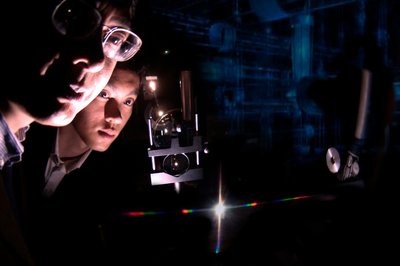Nanophotonics enables a new kind of optical spectrometer
By bringing nanophotonics technology to traditional optical spectroscopy, a new kind of optical spectrometer with functions of sensing and spectral measurement has been demonstrated by a research team at The University of Alabama in Huntsville.
Dr Junpeng Guo, Associate Professor of Electrical Engineering and Optics at UAHuntsville, recently created a new nanoscale photonic device, called a super nanograting, with the assistance of his doctoral student, Haisheng Leong. With a fabricated super nanograting, Dr Guo’s group demonstrated a new kind of optical sensing apparatus called spectrometer sensors.

Traditional optical spectrometers measure the spectra of light, while traditional optical sensors use light to detect the presence of chemicals. A spectrometer sensor is an optical spectrometer and also a chemical sensor because it measures the optical resonance spectrum that is controlled by chemicals bonded on the nanostructure surface. A spectrometer sensor with a super nanoslit metal grating was first published in Optics Letters and a spectrometer sensor with a super nanohole metal grating was published recently in Optics Express.
Nanogratings are periodic nanostructures with the feature size in the nanometre scale. One nanometre is one millionth of a millimetre, about 1/50,000th of the diameter of a human hair. Because the feature size of nanostructures is less than the wavelength of light, we are not able to see nanostructures with our eyes. However, light can sense nanostructures by strong absorptions at specific wavelengths. This phenomenon is called optical resonance of nanostructures, a fundamental phenomenon in optics.
Optical resonances of nanostructures typically are measured by using optical spectrometers. By creating a super-grating pattern of nanostructures, the UAHuntsville team made super diffraction gratings with nanograting structures. With the super nanograting, the resonance of the nanostructure can be measured with a photodetector array. That way, the use of an optical spectrometer is not needed.
The nanostructures, such as nanoholes or nanoslits, are made by using a tightly focused electron beam, a technique called electron-beam lithography. Nanostructure patterns were first drawn with a computer and then sent to the electron-beam lithography machine to control the movement of the tightly focused electron beam to write nanoholes or any other nanostructure patterns in a thin layer of special polymer called e-beam resist.
The e-beam written polymer layer is then developed so the nanostructure patterns are imprinted to the thin polymer layer. The patterned polymer layer works like a mask and an argon ion etching process is used to transfer the pattern from the polymer layer to the thin metal film underneath it. This device was made by Leong.
The super nanograting is a super-period nanohole array drilled in a thin gold film on a transparent glass substrate. The thickness of the gold film is 60 nanometres and the size of the nanoholes is about 100 nanometres. The periodic nanoholes in the thin metal film support collective free electron oscillations, referred to as surface plasmons, in the nanostructured metal.
The super nanogratings have rich physics that needs to be investigated, Dr Guo said. A paper he wrote and published in Applied Physics Letters is trying to explain the resonance mode splitting phenomenon observed in the super-nanohole grating. This splitting could be utilised to make better sensitivity chemical sensors.
The spectrometer sensors can detect toxins or contaminants in very small quantities. UAHuntsville recently filed a patent to license the new technology.
“Spectrometer sensors are best suited in applications requiring small size and weight,” Dr Guo said. He said that such small size and lightweight sensors may be useful for NASA space exploration applications like measuring the chemical makeup on the surface of Mars.
Plasma-modified graphene enhances gas sensors
Researchers have improved gas-sensing technology by treating graphene sheets with plasma under...
Laser-powered device could detect microbial fossils on Mars
The first life on Earth formed four billion years ago, as microbes living in pools and seas: but...
Life's building blocks found in Bennu asteroid sample
A new analysis of samples from the asteroid Bennu reveals that evaporated water left a briny...




